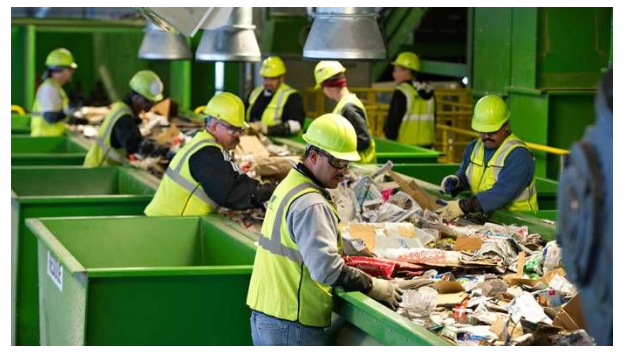
Squander the executives is a basic part of current living, fundamental for keeping a solid climate and economic future. This extreme aid will investigate the three urgent procedures of waste administration: Lessen, Reuse, and Reuse. By getting and executing these practices, people and networks can fundamentally lessen their natural effects and add to a greener planet.
Understanding Waste Management
Waste management incorporates the combination, transportation, and expulsion of junk, sewage, and different side effects. The fundamental goal is to decrease the negative effects of waste on human prosperity and the environment. Effective waste organization approaches are fundamental for controlling pollution, saving resources, and lightening natural change.
Reduce: Minimizing Waste at the Source
The most vital phase in squandering the executives is squandering decrease. This includes limiting how much waste is created at the source. By embracing careful utilization of propensities, people can fundamentally bring down their waste results. Here are a viable ways of diminishing waste:
1. Opt for Minimal Packaging
Pick items with insignificant or biodegradable bundling. Many organizations currently offer eco-accommodating bundling choices that diminish plastic waste.
2. Buy in Bulk
Buying in mass decreases how much bundling waste is. It is additionally normal and more conservative.
3. Avoid Single-Use Items
Single-use things, like plastic containers, straws, and sacks, contribute altogether to squander. Pick reusable choices like metal straws, fabric packs, and refillable water bottles.
4. Mindful Shopping
Prior to making a buy, consider in the event that you really need the thing. Lessening pointless buys can altogether diminish squandering.
Reuse: Giving Items a Second Life
The following stage in viable waste administration is reuse. Reusing things expands their lifecycle, decreasing the requirement for new items and limiting waste. Here are some commonsense ways of integrating reuse into day to day existence:
1. Donate and Buy Second-Hand
Giving things you never again need and purchasing recycled merchandise can lessen waste and back your nearby local area.
2. Repurpose Household Items
Numerous family things can be reused. For example, glass containers can be utilized for stockpiling and old shirts can be transformed into cleaning clothes.
3. Repair Instead of Replace
Preceding discarding something destroyed, consider if it will in general be fixed. Various things, from contraptions to furniture, can be fixed, extending their usable life.
4. Reusable Containers and Bags
Utilize reusable compartments for food capacity and shopping sacks for food. This diminishes the dependence on single-use plastics and other expendable materials.
Recycle: Turning Waste into Resources
Recycling is the method involved with changing over squandering materials into new items. This saves regular assets as well as lessens how much waste is shipped off landfills. Compelling reusing requires understanding what materials can be reused and how to sort and discard them appropriately.
1. Know Your Recyclables
Typically recyclable materials integrate paper, cardboard, glass, metals, and certain plastics. As a matter of fact investigate neighborhood reusing rules to grasp what can and can’t be reused in your space.
2. Proper Sorting
Appropriately sort recyclables to keep away from defilement. Tainted reusing can prompt whole clusters to be shipped off landfills.
3. Clean and Dry
Guarantee that recyclables are spotless and dry prior to setting them in the reusing container. Food buildup and fluids can debase reusing materials.
4. Participate in Recycling Programs
Take advantage of adjacent reusing programs, including curbside pickup, drop-off centers, and thought reusing for equipment, batteries, and hazardous materials.
The Role of Technology in Waste Management
Headways in squandering the executives’ innovation are assuming an urgent part in working on the squandering decrease, reuse, and reusing endeavors. Savvy receptacles, reusing robots, and waste-to-energy advances are upsetting the manner in which we handle squandering.
1. Smart Bins
Shrewd containers outfitted with sensors can sort squander all the more productively, guaranteeing higher paces of reusing and treating the soil.
2. Recycling Robots
Mechanical frameworks are being created to sort and process recyclables more precisely and effectively than human specialists.
3. Waste-to-Energy
Squander to-energy advancements convert non-recyclable waste into energy, lessening the volume of waste shipped off landfills and creating sustainable power.
Conclusion
Compelling waste management is fundamental for a feasible and greener future. By embracing the standards of diminish, reuse, and reuse, people and networks can fundamentally bring down their ecological effects. Combined with progressions in innovation, these practices structure the foundation of a powerful waste administration framework that preserves assets as well as advances a better planet. Begin carrying out these methodologies today to add to a more feasible tomorrow.
FAQs:
1. What is the primary goal of waste management?
- The essential objective of waste administration is to lessen the adverse consequences of waste on human wellbeing and the climate. This includes the assortment, transportation, and removal of waste in a way that controls contamination, rations assets and mitigates environmental change.
2. How can individuals reduce waste at the source?
- People can lessen squandering at the source by picking negligible bundling, purchasing in mass, keeping away from single-use things, and rehearsing careful shopping to keep away from superfluous buys.
3. What are some practical ways to reuse household items?
- Down to earth ways of reusing family things incorporate giving and purchasing second-hand, reusing things, (for example, utilizing glass containers for capacity or old shirts as cleaning fabrics), fixing things as opposed to supplanting them, and utilizing reusable compartments and sacks.
4. What materials are typically recyclable, and what should individuals know about proper recycling?
- Ordinarily, recyclable materials incorporate paper, cardboard, glass, metals, and certain plastics. People ought to know their neighborhood reusing rules, appropriately sort recyclables to stay away from tainting, guarantee recyclables are perfect and dry, and partake in nearby reusing programs.
5. How is technology advancing waste management practices?
- Innovation is propelling waste administration through advancements like savvy canisters with sensors for effective arranging, reusing robots that interaction with recyclables precisely, and squander to-energy advancements that convert non-recyclable waste into energy, decreasing landfill squandering and producing environmentally friendly power.

